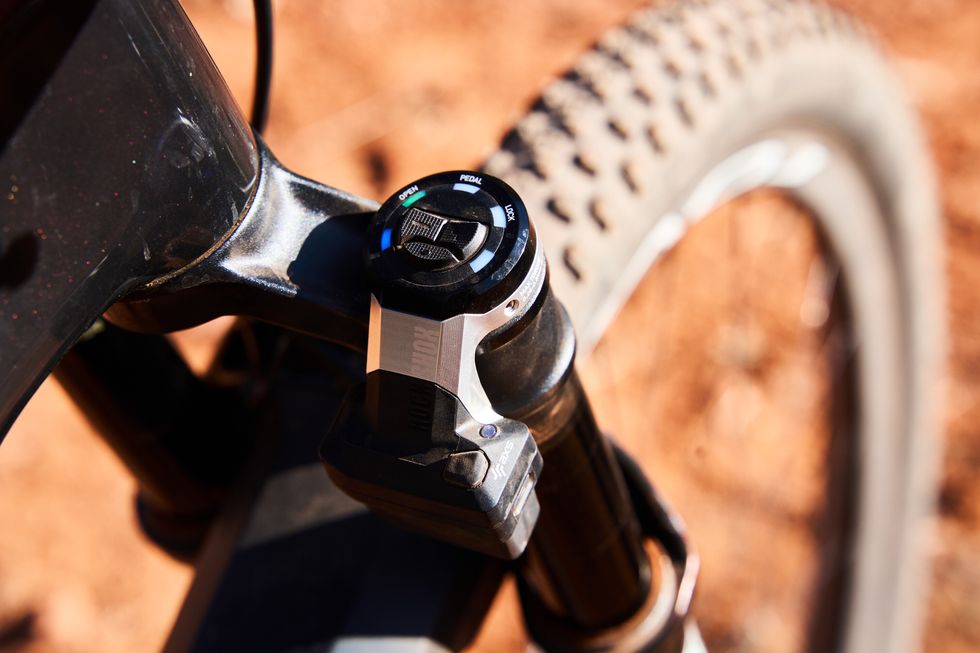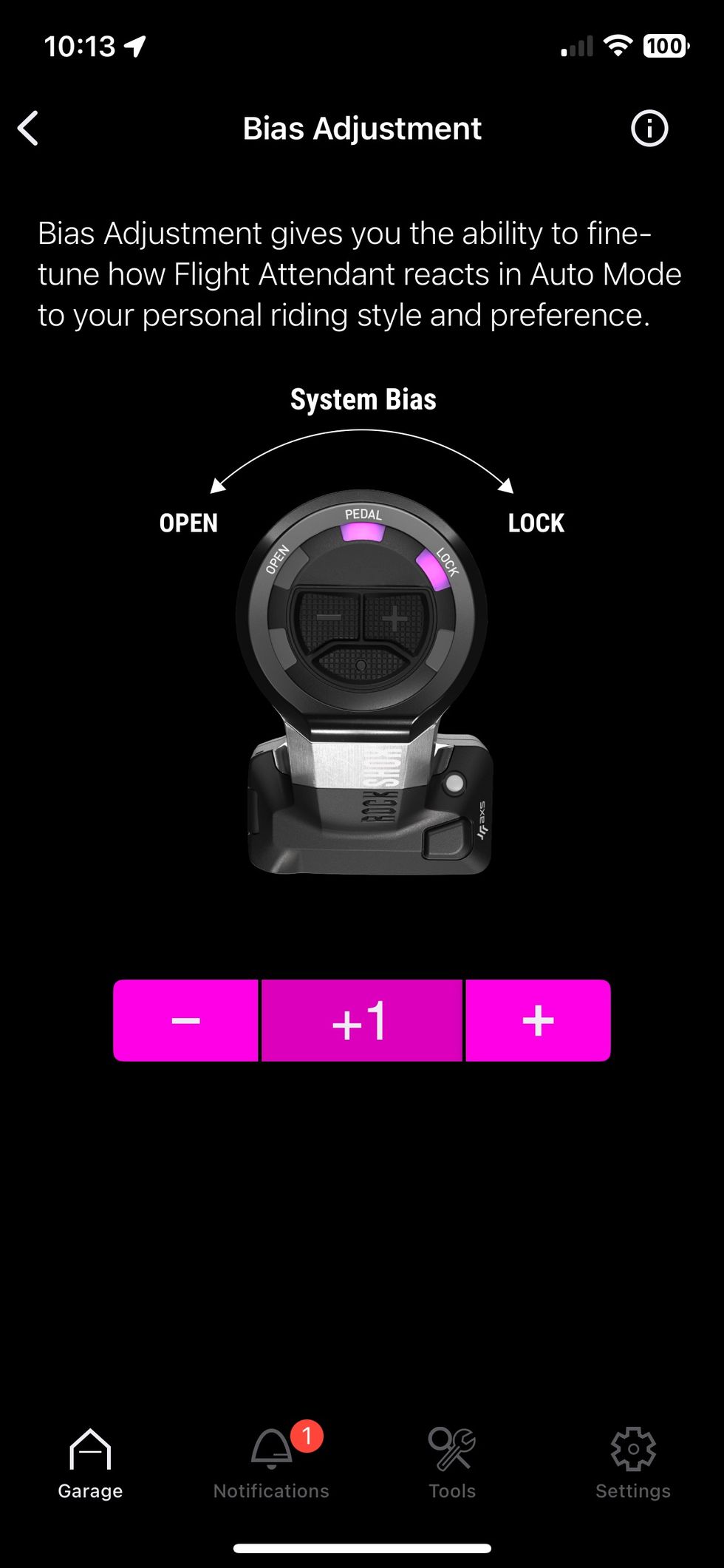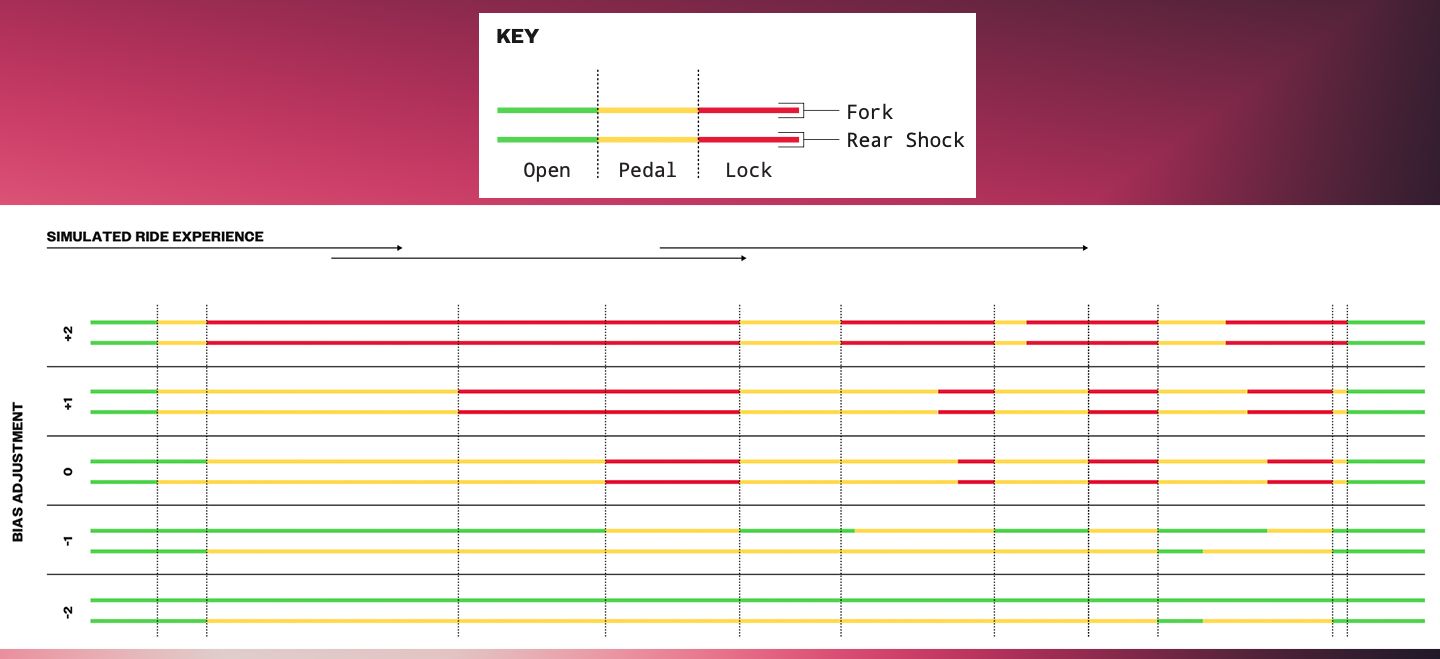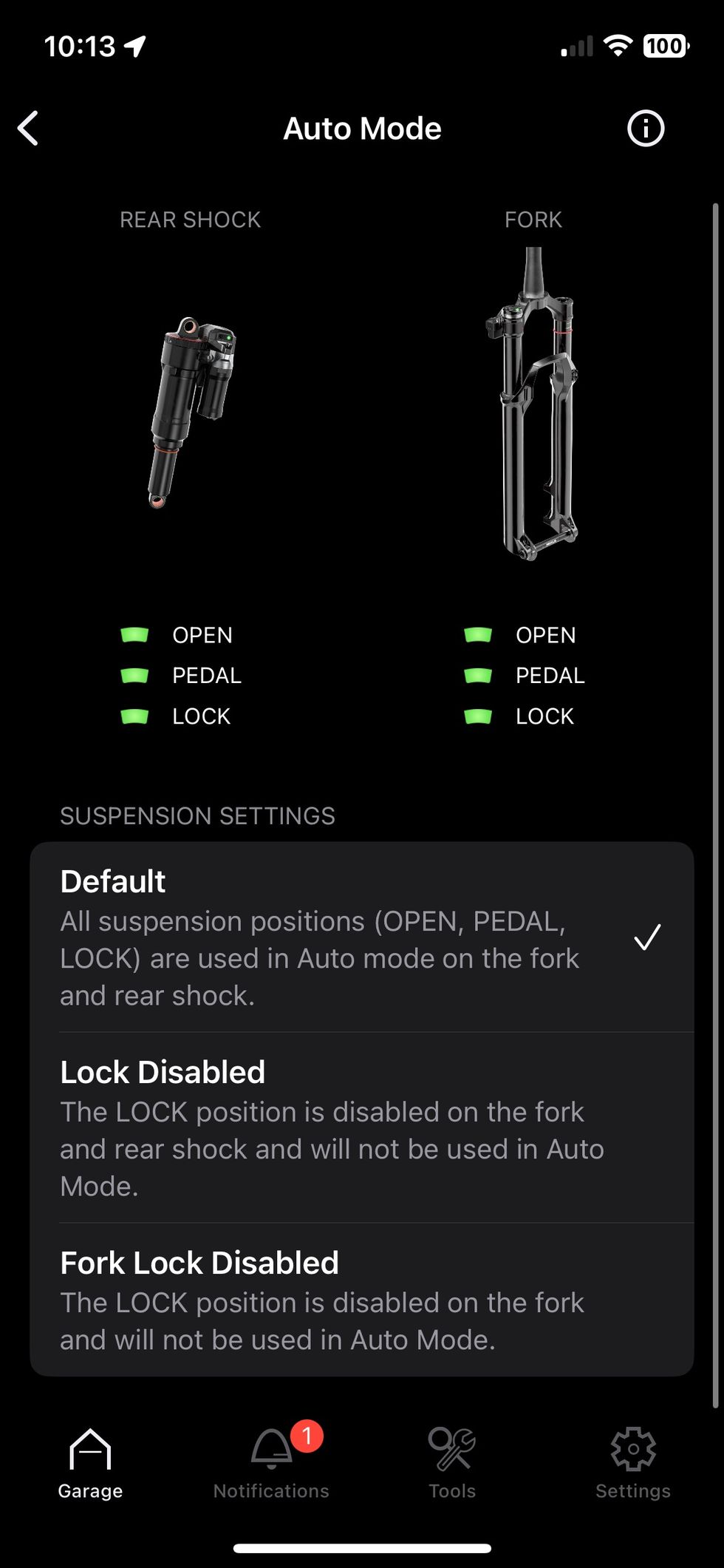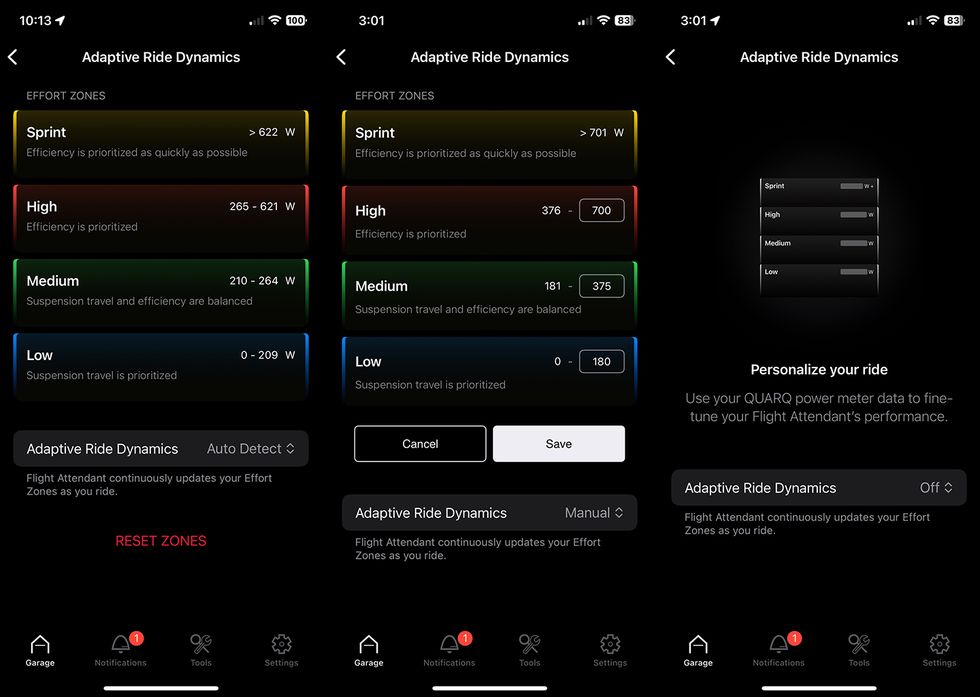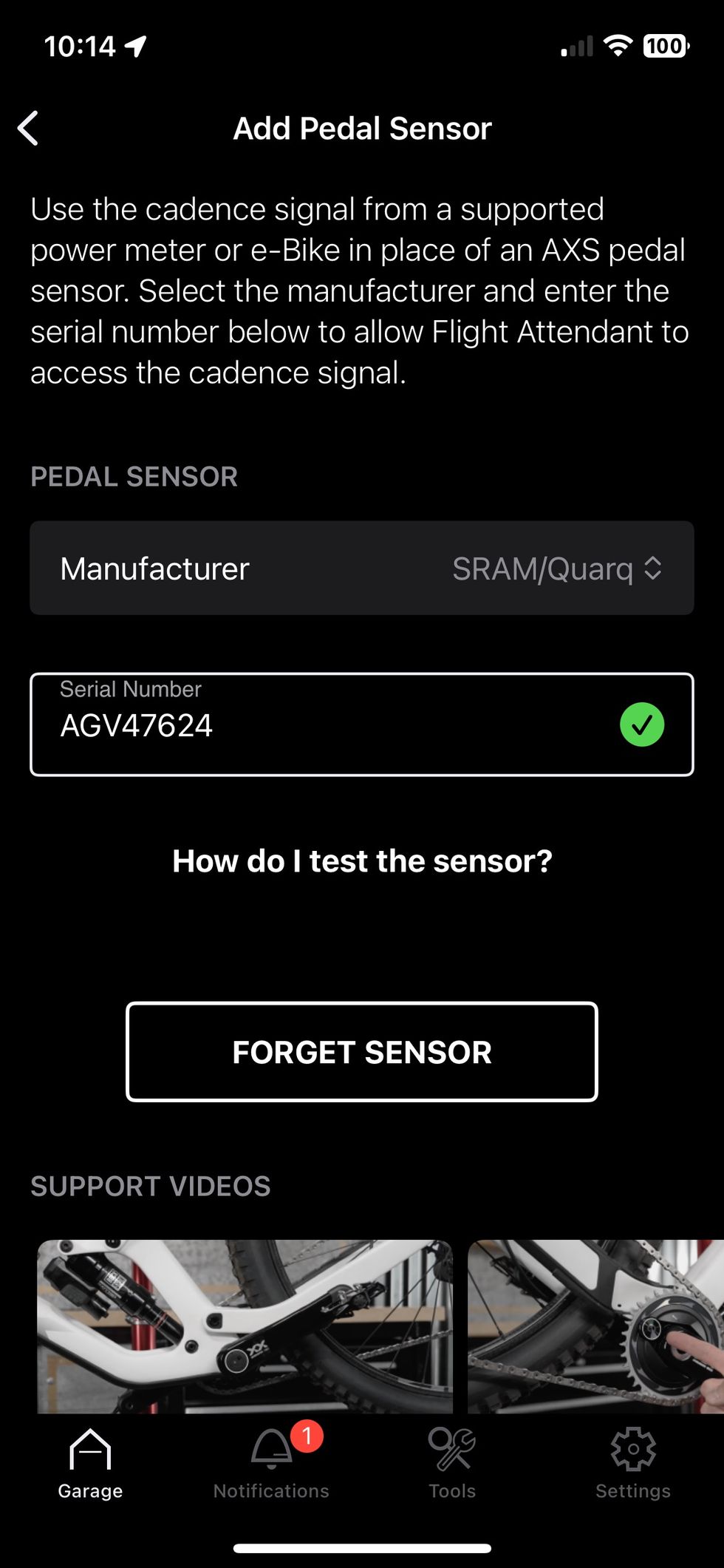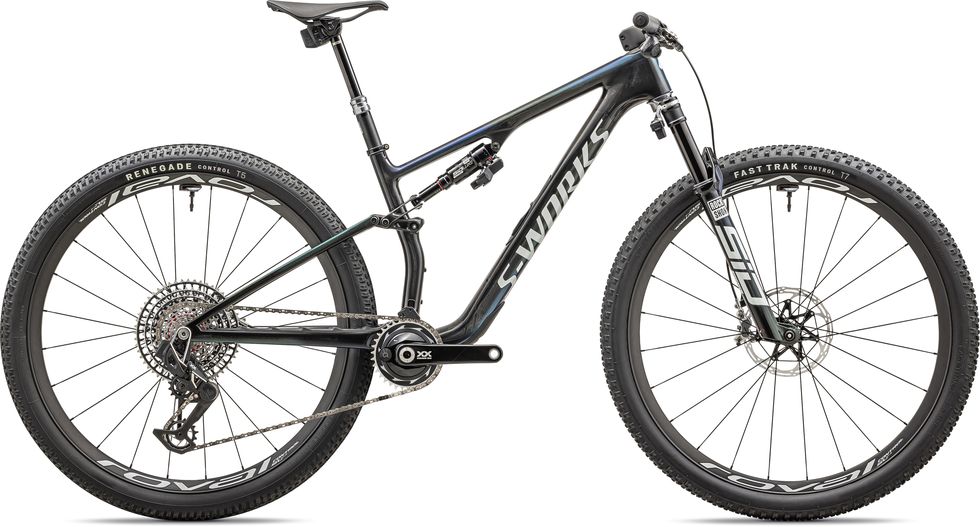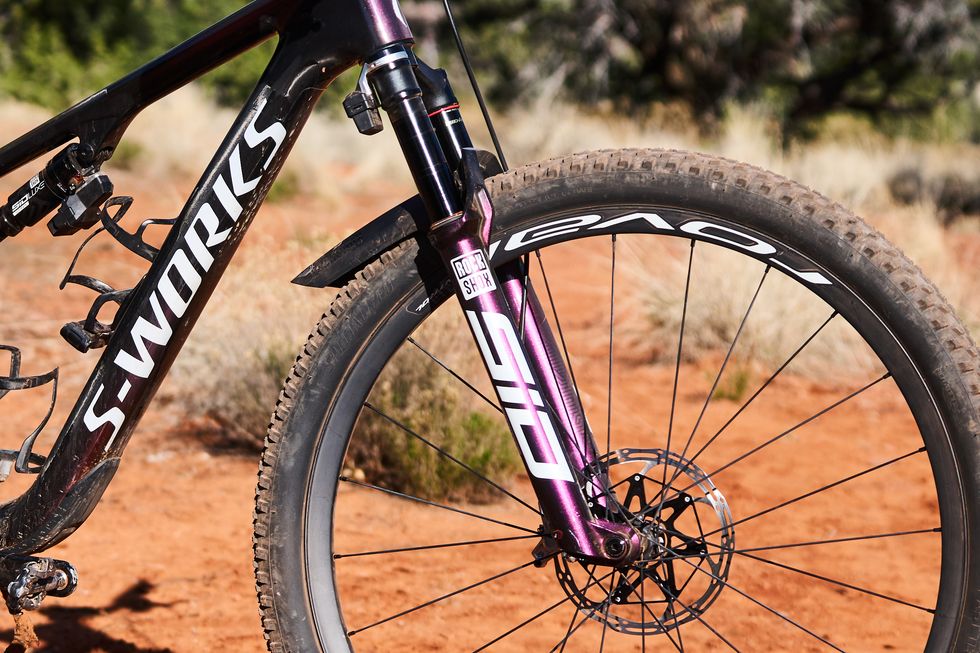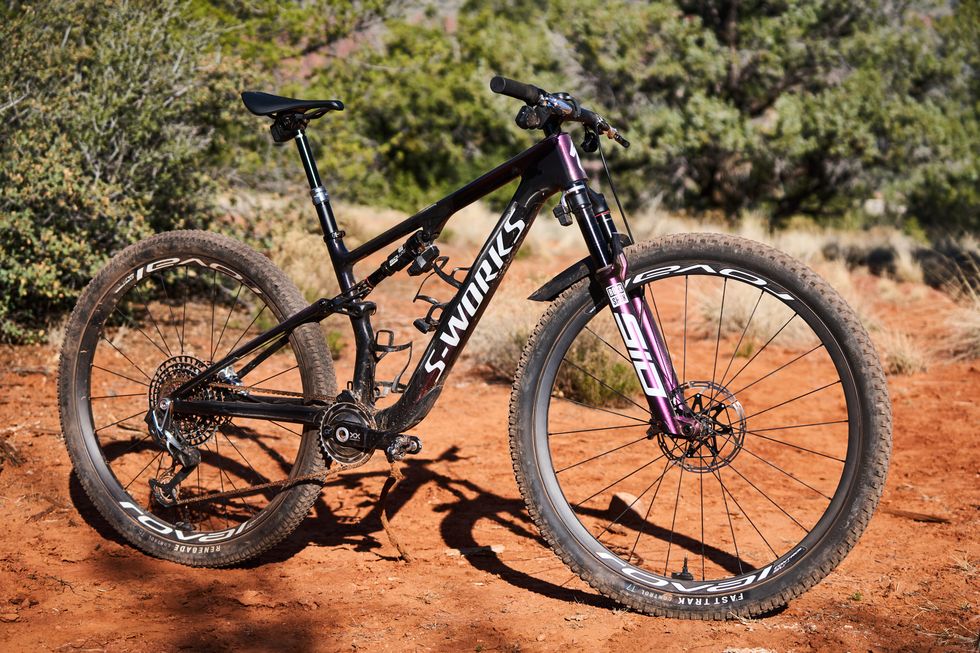RockShox Debuts Flight Attendant for Cross Country
RockShox Flight Attendant, the electronically controlled mountain bike suspension automatically switches modes as you ride.
The Takeaway: RockShox’s latest iteration of its Flight Attendant suspension system is specifically designed for cross country riders and racers. Flight Attendant can automatically switch suspension settings depending on the rider’s preset preferences. A new Adaptive Ride Dynamics mode adds further tunability by using data from a SRAM power meter and previous rides to make on-the-fly suspension adjustments. The system works seamlessly and is a marvel of kit, but it comes at a high price and limited compatibility.
When RockShox launched its Flight Attendant electronic automatically adjusting suspension system in October of 2021, it did so in its longer travel suspension products for trail and enduro riding. While Bicycling’s test team was impressed with the technology and execution, we were mystified why it debuted in the company’s longer travel suspension products and not in cross-country platforms where we felt it would be most effective and embraced.
It took RockShox two and a half years, but Flight Attendant is finally here for the cross-country mountain bike riders with the debut of SID forks with Flight Attendant in 100, 110, and 120mm travels and the SIDLuxe Flight Attendant shock. Along with new components, RockShox has also rolled out significant new features and refinements to Flight Attendant.
We cover the new stuff below, but if you want to read about how these XC-focused Flight Attendant parts perform on a bike, they make a splashy debut as standard equipment on the brand-new Specialized S-Works Epic also launched this week. Find our review here.
Recapping Flight Attendant
To recap, Flight Attendant uses electronic wizardry to automatically switch a bike’s fork and shock damper mode between Open, Pedal, and Lock modes on the fly with no additional input on the rider’s part.
If you’ve flipped a fork’s or shock’s mode switch, or used a handlebar remote, to lock out your suspension as you climb and then unlock it for the descent, Flight Attendant does that for you automatically. But also a lot more.
Flight Attendant collects information from the fork, shock, and pedal sensor and feeds it through an algorithm to tell the fork and shock sensors what mode to select. It may instruct the fork and shock to be in the same mode or pick a “split state” where the shock and fork are in different modes (fork in open and shock in pedal, for example). The system makes a “decision” every five milliseconds, although the physical mode change to the damper takes longer (RockShox does not say how long a mode change takes).
So Many Mode Changes
It’s not just that Flight Attendant automatically changes modes. The real benefit is that it changes suspension mode faster, more often, and more precisely than you could do.
According to RockShox, a prototype version of the new Flight Attendant XC made over 1,300 suspension changes to Nino Schurter’s Scott Spark over 84 minutes as he rode to a record-breaking 34th World Cup win at the Lenzerheide XCO in June 2023. That’s about 16 suspension changes per minute, or one change every four seconds.
Imagine trying to select the best mode for your fork and shock every four seconds while racing all out. Then, you start to see the Flight Attendant’s benefit.
Of course, the size of that benefit depends on your interest and desire to switch your suspension’s mode—and switch it often—while riding. If you don’t fuss with mode switches while riding, then Flight Attendant isn’t for you.
Faster With Flight Attendant?
When Flight Attendant first launched in 2021, RockShox claimed, “You’ll ride further, faster and with less energy used,” but provided no data to support that claim.
So, I tried to put that claim to the test myself. At the end of my semi-controlled “real world” testing, I saw no meaningful difference in my times, perceived effort, or heart rate with Flight Attendant operating or with the bike fixed in open mode.
I sent my data and results to RockShox and asked for the brand’s comment. However, RockShox representatives chose not to. My test (and RockShox’s non-reply) left me concluding that, as impressive as Flight Attendant’s technology and execution were, there wasn’t a significant performance improvement. I said, at the time, “I think the bicycle and equipment brands owe it to us to do more than say their latest product makes us faster—they need to prove it with numbers.”
Perhaps in response to my previous conclusions and criticism, the press kit for the new Flight Attendant XC parts included this statement:
During a testing session with our internal RockShox test team, we found that Flight Attendant rider’s average speed was 1.8-percent faster when compared to those same riders using a manual system. 1.8-percent reads like a small gain but it suggests that in a 90-minute XC World Cup race, a rider on Flight Attendant could have a 96-second advantage.
There it is. RockShox says that for the price of its Flight Attendant kit (around $2,500 [approx ZAR4,600] for fork, shock, and pedal sensor), you can be 1.8 percent faster. However, a close reading—“suggests” and “could”—shows that even that claim is very much hedged.
To me, this is similar to an oversized pulley wheel upgrade. If you’ve done almost everything else (legally) to improve your equipment and (most importantly) fitness, it may be worth spending a lot of money to be 1.8 percent faster. However, for all but the most elite athletes, there is so much more we can do—for a lot less money—that realizes more gains.
But maybe you just like cool technology. Or perhaps you prefer how your bike feels when you use a fork and shock mode switch while riding. Or maybe you haven’t done everything you can to improve your fitness and want to slap down a credit card and walk out of the shop with 1.8 percent (claimed) extra speed. I think those are as good of reasons as any to buy Flight Attendant. You do you; I ain’t gonna yuck your yum.
Multitudinous Adjustments
Flight Attendant is a tinkerer’s delight, with an almost boggling number of adjustments and tuning options.
At its root level, the Flight Attendant fork and shock are air spring, hydraulically damped suspension products. And like any other high-end air/oil bicycle suspension unit, you have air pressure, spring progression (with tokens/volume spacers), and rebound damping as tuning tools. From there, you get into a deep well of tools to personalise Flight Attendant.
The graphic below shows how the different bias settings influence fork and shock mode selection. Plus settings result in the fork and shock locking more often (red) while minus modes see them staying in open mode (green) more often.
Choosing a bias setting towards minus means the suspension is more likely to select the open mode. Choosing a plus bias setting means the suspension will look for more opportunities to select Pedal or Lock mode.
You can shut off Flight Attendant’s automatic mode switching and use dumb mode to flip manually through the three modes. However, engaging the manual mode requires a long press of the mode button on the fork’s Flight Attendant controller. Once the manual mode is selected, the rider can choose one of the three modes by pressing the plus and minus buttons on the fork controller or an additional AXS Pod (if present).
Override Mode turns off Flight Attendant’s automatic switching and selects a preset mode for the fork and shock. This function is only available when the system gets paired with an extra two-button AXS pod. In contrast to dumb mode, you can only flip in and out of the preset Override mode and Automatic mode—you cannot engage Override and then manually flip through the Open, Pedal, and Lock modes.
By default, RockShox sets Override to Lock mode. But, through the AXS app, the rider can set Override to Open or Pedal. Another Override mode adjustment in the app is “Controller Override Timing,” which sets how long a button press is required before Override mode is engaged—instant, 0.25 seconds, or one second.
The Auto Mode setting in the AXS App lets the rider turn off lock mode on the fork and shock, or just the fork, leaving Flight Attendant to automatically select from Open and Pedal modes exclusively.
In the AXS App, the rider can also shut off the LEDs on the fork crown (that indicate suspension position and effort zone) and ride in dark mode. However, shutting off the LEDs does not silence the noticeable whirring noise the motors in the fork and shock make every time they switch modes.
Adaptive Ride Dynamics
With the launch of the Flight Attendant XC system, RockShox added a new layer of data to influence its mode decisions called Adaptive Ride Dynamics (ARD for short). When a power meter gets paired to Flight Attendant, the system considers a rider’s effort in addition to the other influencing factors (trail inputs and bias setting).
Flight Attendant automatically collects power data from the “past several rides” to determine four effort zones: Sprint, High, Medium, and Low. It then uses that data to fine-tune the suspension’s mode selection based on the rider’s effort. RockShox describes it in its press kit as:
- When your effort level reaches Sprint Zone, Adaptive Ride Dynamics encourages the system towards Lock position.
- When your output enters the High Effort Zone, Adaptive Ride Dynamics trends toward a more efficient suspension state.
- As soon as your output dips into the Medium Effort Zone, Adaptive Ride Dynamics trends toward a balance of comfort and efficiency.
- In your Low Effort Zone, when you’re riding more relaxed, Adaptive Ride Dynamics trends towards comfort and compliance.
All this happens automatically in the background—you don’t need to use the SRAM AXS app. It’s also constantly updating, so as your fitness rises or falls, ARD adjusts with your fitness fluctuations. If used with the SRAM AXS app, you can customize ARD by manually setting the effort zones. You can also disable ARD from the app.
One big caveat: Adaptive Ride Dynamics only works with a SRAM or Quarq power meter (or SRAM or Specialized e-bike motor) paired to Flight Attendant. If you’re riding with another power meter—Garmin, Assioma, SRM, etc.—you don’t get ARD.
The New Flight Attendant SID Forks and SIDLuxe Shocks
This launch sees the addition of three new products to the Flight Attendant family.
- SID SL Ultimate Flight Attendant with 32mm stanchions—100mm or 110mm travel, claimed weight of 1,480 grams.
- SID Ultimate Flight Attendant with 35mm stanchions, 120mm travel, claimed weight of 1,624 grams.
- SIDLuxe Ultimate Flight Attendant shock, offered in multiple sizes, claimed weight is 349 grams.
Note: Claimed weights are with the 25-gram AXS battery.
Overall, RockShox claims that upgrading to Flight Attendant XC parts adds about 220 grams to the weight of a bike.
RockShox does provide individual prices for Flight Attendant forks and shocks. However, the parts only function as a three-piece system (fork, shock, and pedal sensor or power meter). For this reason, Flight Attendant is primarily available as original equipment (OE) components on complete bikes or as an upgrade kit for some specific bike models. Bikes compatible with the new SID Flight Attendant Parts are listed below.
Compatible Bikes
In addition to new bikes rolling out with the new parts like the Specialized Epic reviewed here, RockShox states that the new Flight Attendant SID parts are officially compatible with nine existing bike models.
These bikes are the Canyon Lux Trail and Lux World Cup (2023+), Mondraker F-Podium (2023+), Orbea Oiz and Oiz TR (2020-2023), Pivot Mach 4 SL (2023+), Santa Cruz Blur and Blur TR (2022+), and the Specialized Epic Evo (2020-2023).
There are probably numerous other bikes that, technically, fit a 100 to 120mm fork and one of the available SIDLuxe Flight Attendant shock sizes. However, RockShox states it cannot confirm fitment or proper performance for bikes other than the nine listed above or bikes that ship with the parts as OE.
I suspect RockShox’s Flight Attendant landing page will host a fairly up-to-date list of all bikes offered with the parts.
Ride Impressions
After sampling the new Flight Attendant SID forks and shocks on two different bikes and in a handful of different regions and a variety of trails I have almost nothing but positive things to say about its performance.
I find the random and frequent whirring of the fork and shock motors grating—I just can’t tune it out. The other ding to this otherwise great system is, when the fork is in a locked state, a notable mode-switch lag when it encounters a medium-to-large bump. This presents itself as a notchy-feeling fork and a slightly jarring impact. However, the system is quick enough that this lag was only present in the fork and did not affect the shock.
But other than those criticisms, Flight Attendant triumphantly succeeds at its intended purpose: Selecting the best feeling suspension mode at the right time quickly, seamlessly, and with no effort on the rider’s part. With the Bias Adjustment and the other controls available, the rider can fine-tune between a system that’s mostly locked and opens only for bigger bumps or mostly opened and only firms up for the smoothest conditions, or something in the middle.
When conditions are smoother and pedally, it firms up; when the trail gets bumpy or you start coasting downhill, it opens up.
While the technology is unquestionably impressive, even more remarkable is how Flight Attendant drops into the background on the trail. It simply does what it is supposed to do: When conditions are smoother and pedally, it firms up; when the trail gets bumpy or you start coasting downhill, it opens up.
Due to its astronomical price, you might think it does or should do, more. But really “all” it is doing is collecting information and deciding what is the best of the three fork and shock modes for right now and then selecting that mode. It does that every five milliseconds while you ride.
The addition of Adaptive Ride Dynamics is a step forward for the system. With it, Flight Attendant feels smarter and more intuitive because, for example, it will select a different mode if you’re soft pedaling or laying down a full sprint on the same section of trail. ARD makes Flight Attendant’s performance yet more seamless and helps push it further into the background because its decisions feel even more correct—even more aligned with what a rider would choose in a given situation—on the trail.
As a technical exercise, I think Flight Attendant is a triumph. This system is the absolute pinnacle of technology for riders of shorter travel bikes who love lockouts. And for riders who like using different shock modes but don’t like all the manual actuation and having to think about when and where to engage each mode—especially while their attention is focused on racing—this system takes that thinking out of the equation so all they need to focus on is pedalling.
For these two groups of riders, Flight Attendant illustrates the best of what electronics and technology can offer cyclists. It may even convince some riders who were lockout-adverse to ride with lockout.
But Flight Attendant is expensive. And “all” it does is remove the task of choosing a suspension mode from the rider’s plate. At best, this makes the rider 1.8 percent faster.
Whether that’s a worthwhile upgrade for you, I can’t say. But there is no doubt that Flight Attendant is an incredible technology that leverages electronic complexity to make things easier for the rider.
READ MORE ON: cross country Flight Attendant new products rockshox suspension



